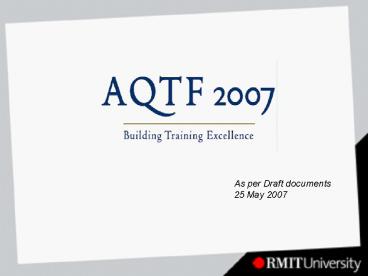Organisational Reviews PowerPoint PPT Presentation
1 / 22
Title: Organisational Reviews
1
As per Draft documents 25 May 2007
2
This presentation
- Why the Change?
- Whats different
- The Essential Standards
- The Excellence Criteria
- The Audit model
- Implications for RMIT
- Time Lines
3
Why the change?
- COAG (Council of Australian Governments)
- - human capital reform agenda
- - workforce development and participation
- The national focus on VET
- - national consistency
- - focus on outcomes (industry
- confidence)
4
Whats different?
- A shift away from a compliance focus to an
outcomes and continuous improvement focus - A stronger focus on teaching and learning
- Introduction of Quality Indicators
- Risk management determines scope and frequency of
Audits - Levels of Recognition as a quality assured
provider - -
5
AQTF 2007
- Essential standards for registration.
- (Must be met in order to deliver and assess
nationally recognised programs) - Standards for State and Territory Registering
Bodies - Excellence Criteria (Voluntary)
- (Follows Australian Business Excellence Awards
principles)
6
ESSENTIAL STANDARDS FOR REGISTRATION
- Comprises
- 9 Conditions of Registration
- (compliance mandatory)
- Three standards
- (Subject to continuous improvement)
- Quality indicators
- Implementation 1July 2007
7
ESSENTIAL STANDARDS
- Conditions of registration
- Before 1 July 2007 the University will have to
sign a declaration that it complies with the 9
Conditions of Registration. - The conditions of registration will only be
audited where there are identified risks
determined by the registering body.
8
ESSENTIAL STANDARDS
- Standard 1 The RTO provides quality training
and assessment across all of its operations - Standard 2 The RTO adheres to principles of
access and equity and maximises outcomes for its
clients - Standard 3 Management systems are responsive to
the needs of clients, staff and stakeholders, and
the environment in which the RTO operates - Implementation 1 July 2007
9
ESSENTIAL STANDARDS
- Quality Indicators
- Employer satisfaction (this includes competency
development and training assessment quality). - Learner satisfaction (this includes learner
engagement and competency development). - Competency completion rate. (This will be
calculated for qualifications and units of
competency.) - Implementation 1 January 2008
10
Excellence Criteria(voluntary)
- Principles, criteria, assessment, and reporting
system for Excellence recognition still being
developed - Based on the Business Excellence framework
- Continuous improvement focus
- Cost/benefits of participation are not yet
apparent (May be linked to criteria for self
managed scope
11
Audit model
- New audit model to reflect focus on outcomes and
continuous improvement (more rigorous). - Scope and frequency of Audits will be based on
the outcome of a risk assessment by the
registering body. - (VRQA in Victoria)
12
Audit Scope
- Two qualifications from each training package
under review to include where possible - Units of competency that have been identified as
high risk by industry - Apprenticeships/ Traineeship Qualifications
- A low and high AQF level
13
Audit Scope
- The assessments for at least two units of
competency for each qualification. The two units
of competency to be high risk (as identified by
industry) or two industry specific units of
competency. - The learning and assessment strategies for all
qualifications
14
Basis of Audits ADRI
- Approach What are your objectives?
- Deployment How are they being implemented? Is
this appropriate? - Results What are the outcomes? How do you know
that you are meeting your objectives? (evidence,
including comparisons) - Improvement What improvements do you make?
15
Outcomes of Audit
- Compliant
- The requirements of the Essential Standards for
Registration have been met. - Minor non-compliance
- Examples may include
- an isolated breach in compliance
- a lapse which has no serious consequence
16
Outcomes of Audit
- High non compliance (20 days to fix)
- An RTO that exhibits
- little or no evidence of meeting the Essential
Standards for Registration - an almost total or total breakdown in the
capacity to manage the RTO including the systems
required to do so - lack of resources to support the delivery of
training
17
Outcomes of Audit
- Critical non compliance
- Examples may include
- a situation where there is a significant risk
of injury or death to people in the training
environment or the current (or future) workplace - a situation resulting in potential risk to
consumers of goods and services produced in the
training environment or (future) workplace.
18
Sanctions
19
Implications for RMIT
- The new AQTF is in alignment with our strategic
objectives - The public risk around registration and
strategic industry audits will be greater - Outcomes measures may be made public
- Evidence of consultation with industry in
development of curriculum is required
20
Implications for RMIT
- Implementation of existing policies will be
critical, e.g. - Program Annual Reports
- Student Surveys
- Program Implementation
- Validation moderation of assessment.
21
Timelines
- Before 1 July 2007 Conditions of Registration
viewed, signed and returned to registering bodies
by RTOs - Auditing against AQTF 2007 from 1 July 2007
- 1 January 2008 Excellence Criteria implemented
- 1 January 2008 Quality Indicators implemented
22
- Questions and
- discussion
Contact Mike quinn Phone 53337 E-mail
michael.quinn_at_rmit.edu.au

